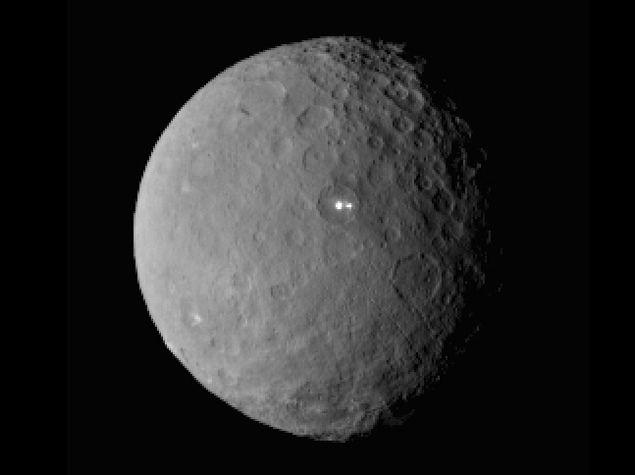- Home
- Science
- Science News
- Nasa's Dawn Spacecraft Reaches Dwarf Planet Ceres for 16 Month Study
Nasa's Dawn Spacecraft Reaches Dwarf Planet Ceres for 16-Month Study

Launched in 2007, the Dawn spacecraft made a 14-month tour of the asteroid Vesta before steering itself toward Ceres, the largest body in the asteroid belt between Mars and Jupiter.
Dawn shifted its path to allow itself to be captured by Ceres' gravity at 7:39 a.m. EST (1239 GMT), becoming the first spacecraft to orbit a dwarf planet.
"We feel exhilarated," lead researcher Chris Russell at the University of California, Los Angeles, said in a statement after Dawn radioed back to Earth.
Nasa's New Horizons probe is scheduled to fly by another dwarf planet, Pluto, in the far reaches of the solar system later this year. Like Ceres, Pluto was once considered a full-fledged planet, but was reclassified after the discovery of similar bodies.
Dawn will spend about a month repositioning itself from its initial orbit about 38,000 miles (61,000 km) above Ceres to the first survey altitude of 2,730 miles (4,400 km).
By the time the mission ends in June 2016, Dawn will have flown as low as 230 miles (375 km) above the surface.
Scientists already have a mystery to solve. Last month as Dawn neared Ceres, it relayed images of startlingly bright spots on the surface, which could be patches of subsurface ice exposed after an asteroid or comet impact. They also could be deposits of salt or other minerals.
"These spots were extremely surprising," Dawn scientist Carol Raymond of the National Aeronautics and Space Administration's Jet Propulsion Laboratory in Pasadena, California, told reporters on Monday.
Scientists suspect Ceres may have had an underground ocean early in its history that later froze. Europe's Herschel telescope last year detected water vapor around Ceres, a clue that impacting bodies may periodically send plumes of watery material shooting into space. Dawn will try to confirm those findings.
The mission, which is costing Nasa about $473 million, is the first to include stops at more than one extraterrestrial body.
Dawn is outfitted with an ion electric propulsion engine, which requires far less fuel that traditional chemical engines. The spacecraft was designed and built by Orbital ATK.
No new pictures of Ceres are expected until April when Dawn will be able to see the sunlight side of its new home.
© Thomson Reuters 2015
For the latest tech news and reviews, follow Gadgets 360 on X, Facebook, WhatsApp, Threads and Google News. For the latest videos on gadgets and tech, subscribe to our YouTube channel. If you want to know everything about top influencers, follow our in-house Who'sThat360 on Instagram and YouTube.
Related Stories
- Samsung Galaxy Unpacked 2025
- ChatGPT
- Redmi Note 14 Pro+
- iPhone 16
- Apple Vision Pro
- Oneplus 12
- OnePlus Nord CE 3 Lite 5G
- iPhone 13
- Xiaomi 14 Pro
- Oppo Find N3
- Tecno Spark Go (2023)
- Realme V30
- Best Phones Under 25000
- Samsung Galaxy S24 Series
- Cryptocurrency
- iQoo 12
- Samsung Galaxy S24 Ultra
- Giottus
- Samsung Galaxy Z Flip 5
- Apple 'Scary Fast'
- Housefull 5
- GoPro Hero 12 Black Review
- Invincible Season 2
- JioGlass
- HD Ready TV
- Laptop Under 50000
- Smartwatch Under 10000
- Latest Mobile Phones
- Compare Phones
- Honor Magic 7 RSR Porsche Design
- Moto G15 Power
- Moto G15
- Realme 14x 5G
- Poco M7 Pro 5G
- Poco C75 5G
- Vivo Y300 (China)
- HMD Arc
- Asus Zenbook S 14
- MacBook Pro 16-inch (M4 Max, 2024)
- Honor Pad V9
- Tecno Megapad 11
- Redmi Watch 5
- Huawei Watch Ultimate Design
- Sony 65 Inches Ultra HD (4K) LED Smart TV (KD-65X74L)
- TCL 55 Inches Ultra HD (4K) LED Smart TV (55C61B)
- Sony PlayStation 5 Pro
- Sony PlayStation 5 Slim Digital Edition
- Blue Star 1.5 Ton 3 Star Inverter Split AC (IC318DNUHC)
- Blue Star 1.5 Ton 3 Star Inverter Split AC (IA318VKU)

















